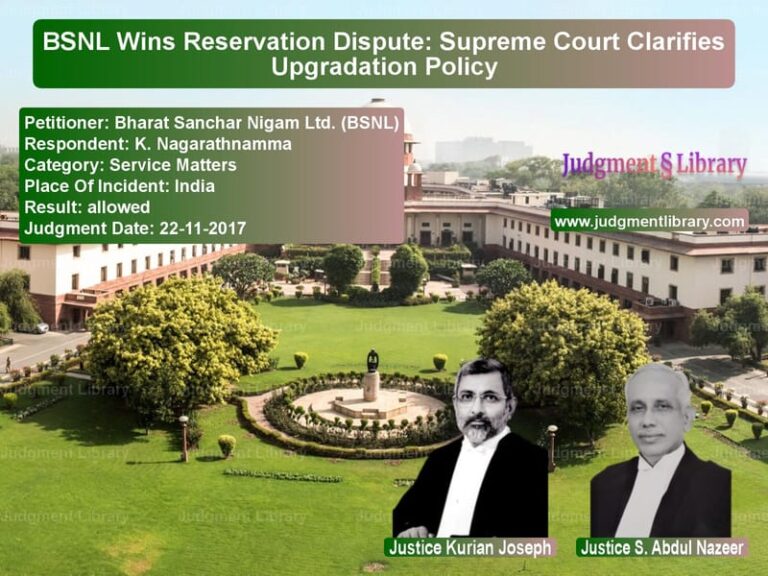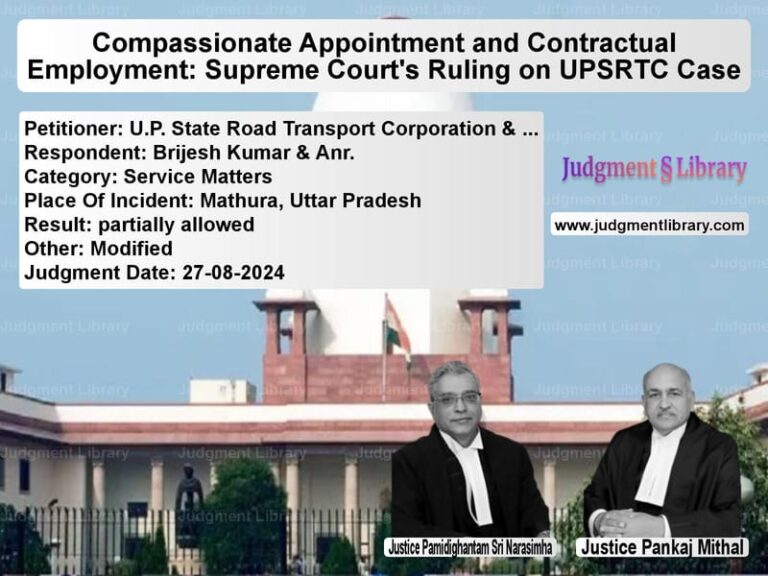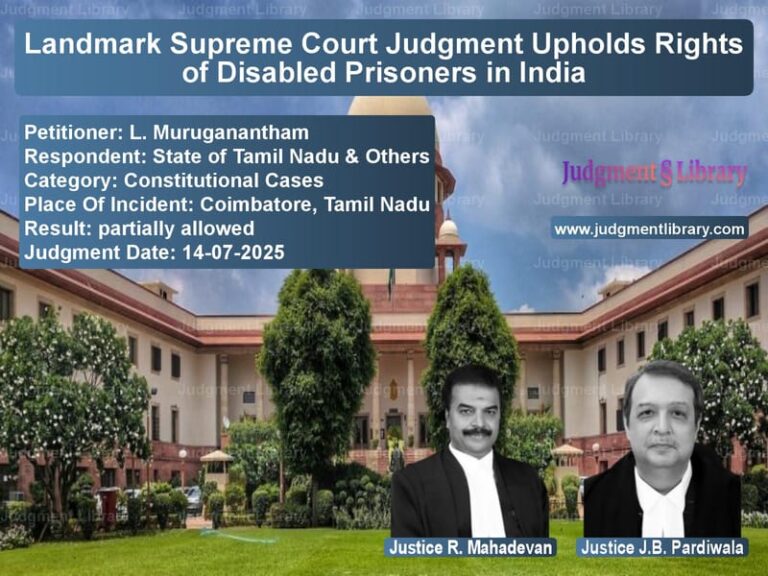Electricity Tariff Regulations: Supreme Court Rules on Damodar Valley Corporation’s Tariff Disputes
The case of Bhaskar Shrachi Alloys Ltd. & Ors. vs. Damodar Valley Corporation & Ors. revolves around the determination of electricity tariffs by the Damodar Valley Corporation (DVC) and whether its tariff-setting powers should be governed by the Electricity Act, 2003 or the older Damodar Valley Corporation Act, 1948. The Supreme Court had to decide on several issues, including the applicability of tariff regulations, pension and gratuity contributions, debt-equity ratios, and whether certain expenses should be passed on to electricity consumers.
Background of the Case
DVC was established under the Damodar Valley Corporation Act, 1948, to control flooding, generate and distribute power, and undertake irrigation and other development activities in the Damodar Valley area spanning West Bengal and Jharkhand. It had the power to determine its own electricity tariffs under Section 20 of the 1948 Act. However, the Electricity Act, 2003 centralized tariff regulation under the Central Electricity Regulatory Commission (CERC). The key question was whether DVC should still have tariff autonomy or if it should be subject to CERC’s regulations.
Legal Issues Raised
1. Applicability of the Electricity Act, 2003 vs. the DVC Act, 1948
One of the primary legal questions was whether the 2003 Act completely overruled the provisions of the DVC Act, particularly regarding tariff fixation.
2. Determination of Tariff and the Role of CERC
The CERC, in its order dated October 3, 2006, determined the electricity tariff chargeable by DVC for the period 2004-2009. It considered various factors like return on equity, depreciation rates, pension contributions, and cost allowances.
3. Challenges to CERC’s Tariff Determination
DVC, as well as industrial consumers of electricity such as Bhaskar Shrachi Alloys Ltd. and others, challenged CERC’s tariff order before the Appellate Tribunal for Electricity. The tribunal, in its order dated November 23, 2007, upheld some aspects of CERC’s order but remanded other issues for reconsideration.
Arguments by the Parties
Arguments by the Appellant (Bhaskar Shrachi Alloys Ltd. & Other Consumers)
- Consumers argued that DVC should not be allowed to pass on excessive expenses, such as social welfare obligations and pension liabilities, to electricity consumers.
- They contended that CERC’s tariff regulations should completely override the DVC Act, 1948, since the 2003 Act created a new regulatory framework.
- The consumers challenged the methodology used by CERC for determining depreciation rates, debt-equity ratios, and pension and gratuity contributions.
Arguments by the Respondent (Damodar Valley Corporation)
- DVC argued that it had unique responsibilities, including flood control, afforestation, and irrigation, which should be factored into tariff calculations.
- It contended that the 1948 Act allowed it to determine its own tariffs and that certain provisions of the older law should continue to apply under the fourth proviso to Section 14 of the Electricity Act, 2003.
- DVC sought higher returns on equity and a different approach to pension and gratuity contributions.
Supreme Court’s Observations
The Supreme Court provided a detailed analysis of the legal provisions and the factual circumstances surrounding the case.
1. Co-existence of the 1948 Act and the 2003 Act
The Court ruled that while the Electricity Act, 2003, was the primary legislation governing electricity tariffs, the DVC Act, 1948, was not completely overridden. The Court stated:
“The fourth proviso to Section 14 of the Electricity Act, 2003, allows certain provisions of the DVC Act, 1948, to continue applying, provided they are not inconsistent with the 2003 Act.”
2. Role of the Central Electricity Regulatory Commission
The Court held that CERC had the authority to determine electricity tariffs for DVC. It ruled:
“The tariff determination function of DVC under the 1948 Act is inconsistent with the regulatory mechanism established by the 2003 Act. Therefore, tariff fixation falls within the purview of CERC.”
3. Specific Tariff Issues Addressed
Depreciation Rates and Sinking Fund
The Court upheld the Appellate Tribunal’s decision that the depreciation rates should be determined under Section 40 of the DVC Act, 1948, rather than CERC’s tariff regulations.
Pension and Gratuity Contributions
The Court ruled that pension and gratuity liabilities should be fully recovered through the tariff, rejecting CERC’s earlier approach of a 40:60 split between DVC and consumers.
Debt-Equity Ratio
The Court ruled that pre-1992 projects should have a 50:50 debt-equity ratio, while post-1992 projects should follow the standard 70:30 ratio.
Other Expenses and Cross-Subsidization
The Court upheld the inclusion of certain social welfare expenses in the tariff, stating:
“The social responsibilities assigned to DVC under the 1948 Act cannot be ignored. However, these expenses must be clearly identified and justified.”
Final Judgment
The Supreme Court upheld the Appellate Tribunal’s order and ruled:
- The Electricity Act, 2003, governs DVC’s tariff fixation, but provisions of the 1948 Act that are not inconsistent will continue to apply.
- CERC has the final authority to determine tariffs, but it must consider the unique responsibilities of DVC.
- The Court rejected challenges by consumers seeking to eliminate cross-subsidization of non-electricity expenses.
- It upheld pension and gratuity liabilities being fully passed on to consumers.
- The decision provided clarity on the framework for future tariff determinations involving DVC.
Implications of the Judgment
The ruling has significant implications for regulatory governance in the power sector:
- Clarifies the role of CERC: Confirms that CERC is the final authority for tariff determination, even for statutory corporations like DVC.
- Maintains financial stability for DVC: Allows DVC to recover pension liabilities and certain social welfare expenses through tariffs.
- Balances consumer interests: While upholding some cross-subsidization, the judgment ensures transparency in tariff calculations.
- Establishes legal precedent: Reinforces that older laws governing electricity companies must align with modern regulatory frameworks.
Conclusion
The Supreme Court’s decision in Bhaskar Shrachi Alloys Ltd. & Ors. vs. Damodar Valley Corporation & Ors. serves as an important precedent in balancing regulatory control and financial sustainability in the electricity sector. By affirming CERC’s authority while allowing certain aspects of the DVC Act, 1948, to remain in force, the ruling provides a structured approach for managing complex regulatory conflicts in India’s power industry.
Petitioner Name: Bhaskar Shrachi Alloys Ltd..Respondent Name: Damodar Valley Corporation & Ors..Judgment By: Justice Ranjan Gogoi, Justice R. Banumathi.Place Of Incident: West Bengal and Jharkhand.Judgment Date: 23-07-2018.
Don’t miss out on the full details! Download the complete judgment in PDF format below and gain valuable insights instantly!
Download Judgment: Bhaskar Shrachi Allo vs Damodar Valley Corpo Supreme Court of India Judgment Dated 23-07-2018.pdf
Direct Downlaod Judgment: Direct downlaod this Judgment
See all petitions in Company Law
See all petitions in Bankruptcy and Insolvency
See all petitions in Corporate Compliance
See all petitions in Judgment by Ranjan Gogoi
See all petitions in Judgment by R. Banumathi
See all petitions in dismissed
See all petitions in supreme court of India judgments July 2018
See all petitions in 2018 judgments
See all posts in Corporate and Commercial Cases Category
See all allowed petitions in Corporate and Commercial Cases Category
See all Dismissed petitions in Corporate and Commercial Cases Category
See all partially allowed petitions in Corporate and Commercial Cases Category







